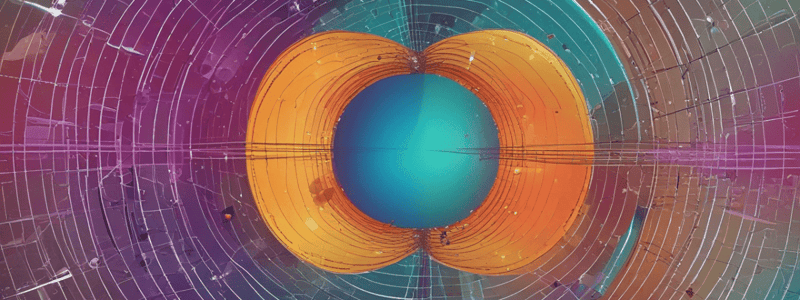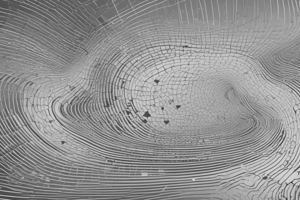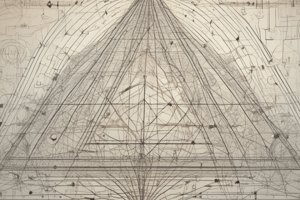Podcast
Questions and Answers
What are the two main characteristics of a vector quantity?
What are the two main characteristics of a vector quantity?
Magnitude and direction
What is the key difference between a scalar and a vector quantity?
What is the key difference between a scalar and a vector quantity?
A scalar has only magnitude, while a vector has both magnitude and direction
What two methods are used to find the direction of the resultant of two vectors?
What two methods are used to find the direction of the resultant of two vectors?
The triangle and parallelogram law
What mathematical techniques can be used to find the perpendicular components of a vector?
What mathematical techniques can be used to find the perpendicular components of a vector?
Give an example of a vector quantity
Give an example of a vector quantity
What is the unit of speed?
What is the unit of speed?
What is the formula that relates distance, speed, and time?
What is the formula that relates distance, speed, and time?
What is the characteristic of speed that distinguishes it from a vector quantity?
What is the characteristic of speed that distinguishes it from a vector quantity?
What is the primary difference between displacement and distance?
What is the primary difference between displacement and distance?
What is the formula for velocity?
What is the formula for velocity?
What is the unit of velocity in the SI system?
What is the unit of velocity in the SI system?
How does the concept of velocity differ from the concept of speed?
How does the concept of velocity differ from the concept of speed?
Under what condition would an object fall with an acceleration due to gravity 'g'?
Under what condition would an object fall with an acceleration due to gravity 'g'?
What is the implication for body moving at constant speed of acceleration being a vector quantity?
What is the implication for body moving at constant speed of acceleration being a vector quantity?
What is the significance of the acceleration 'g' in the context of gravity?
What is the significance of the acceleration 'g' in the context of gravity?
What is the relationship between velocity and acceleration?
What is the relationship between velocity and acceleration?
What is the formula for acceleration in terms of intitial velovity, final velocity and time?
What is the formula for acceleration in terms of intitial velovity, final velocity and time?
What is the relationship between an object's acceleration and its velocity, as described by the equation v = u + at?
What is the relationship between an object's acceleration and its velocity, as described by the equation v = u + at?
What is the second equation of motion?
What is the second equation of motion?
What is the third equation of motion?
What is the third equation of motion?
How does the concept of acceleration relate to the concept of velocity?
How does the concept of acceleration relate to the concept of velocity?
What is the significance of the variables u and v in the equations of motion?
What is the significance of the variables u and v in the equations of motion?
What is the physical quantity that measures the amount of matter in a body, and what is its unit in the SI system?
What is the physical quantity that measures the amount of matter in a body, and what is its unit in the SI system?
What is the product of an object's mass and velocity, and what is its unit in the SI system?
What is the product of an object's mass and velocity, and what is its unit in the SI system?
State the principle of conservation of momentum, and explain its significance in a closed system.
State the principle of conservation of momentum, and explain its significance in a closed system.
Write an equation that represents the principle of conservation of momentum for a two-object system, and explain the variables used in the equation.
Write an equation that represents the principle of conservation of momentum for a two-object system, and explain the variables used in the equation.
What is the condition required for the principle of conservation of momentum to be applicable, and why is it important in physics?
What is the condition required for the principle of conservation of momentum to be applicable, and why is it important in physics?
What is the unit of force in the International System of Units (SI), and what is the definition of one unit of this force?
What is the unit of force in the International System of Units (SI), and what is the definition of one unit of this force?
What is the relationship between three forces that keep a particle at rest?
What is the relationship between three forces that keep a particle at rest?
What is the main formula involving force?
What is the main formula involving force?
What is the condition required for a particle to be at rest, in terms of the forces acting on it?
What is the condition required for a particle to be at rest, in terms of the forces acting on it?
What is the definition of a force, and how does it relate to the motion of an object?
What is the definition of a force, and how does it relate to the motion of an object?
What is the unit of force, and how is it defined in terms of mass and acceleration?
What is the unit of force, and how is it defined in terms of mass and acceleration?
What is the condition for three forces to keep a particle at rest?
What is the condition for three forces to keep a particle at rest?
What is the relationship between force and acceleration, according to Newton's laws?
What is the relationship between force and acceleration, according to Newton's laws?
What is the net force on an object that is at rest, and what are the implications for the forces acting on it?
What is the net force on an object that is at rest, and what are the implications for the forces acting on it?
How does the concept of force relate to the motion of an object, according to Newton's laws?
How does the concept of force relate to the motion of an object, according to Newton's laws?
What is the fundamental principle underlying Newton's First Law of Motion?
What is the fundamental principle underlying Newton's First Law of Motion?
How does the direction of the force applied to an object affect its momentum?
How does the direction of the force applied to an object affect its momentum?
What is the relationship between the action and reaction forces in an interaction between two objects?
What is the relationship between the action and reaction forces in an interaction between two objects?
What is the physical quantity that is proportional to the rate of change of momentum when a force is applied to an object?
What is the physical quantity that is proportional to the rate of change of momentum when a force is applied to an object?
What is the condition under which an object's velocity remains constant?
What is the condition under which an object's velocity remains constant?
Flashcards are hidden until you start studying




